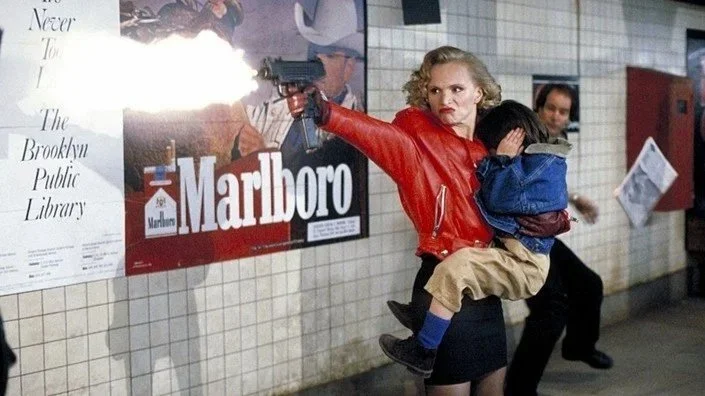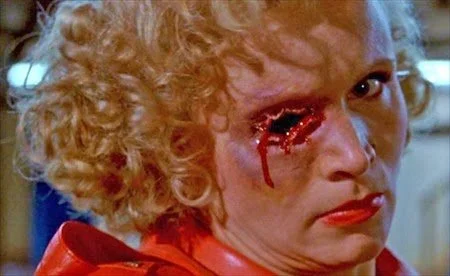Weird Wednesdays: Eve of Destruction (1991)
This screening was part of the Alamo Drafthouse’s Weird Wednesday series. For upcoming shows, click here.
I’ve never known fully what to expect going into a Weird Wednesday screening. Sometimes Alamo shows big budget movies that don’t quite work, like the time I saw the Lindsay Lohan camp classic I Know Who Killed Me in 35mm. Other weeks they manage to find incredibly obscure micro-budget cult classics straight off of a used VHS shelf and give them a moment back in the spotlight. As luck would have it, Eve of Destruction feels like a literal blast from a video store past.
So what is this movie exactly? Honestly, I’m still having a hard time figuring that out. Part 90s action flick, part cautionary tale of the near future, and it’s also a lean melodrama with just enough complexity to withstand its 90-minute run time. But, dear reader, I want to be clear about one thing: this is not a great movie, or necessarily even a good movie. But it is a movie where a sexy lady robot bites off a guy’s dick, and if that seems like the kind of movie you want to learn more about, let’s dive in.
Directed by Duncan Gibbins, who co-wrote the script with Yale Udoff, Eve of Destruction follows a scientist (Renée Soutendijk) who teams up with a terrorist hunter (Gregory Hines) to track down a cyborg she created (also Soutendijk) who’s armed with a nuclear bomb that will explode in 24 hours. As they attempt to save the day, our leads have just enough time to work through the dual challenges of various philosophical misunderstandings and wildly uneven writing.
It’s also worth mentioning at this point that Soutendijk and Hines have little chemistry with each other, and often feel out of sync while in the same shot. It seems Gibbins wanted to cast against type, which is certainly a novel approach given the limitations of the genre he was working within, though it rarely felt like he was able to align his leads' differing performance styles enough to pull off a convincing partnership between their characters.
Curious to know more about Gibbins’ career, a quick IMDB search revealed he kicked off his career directing music videos in the 80s for synth-pop groups like Eurythmics and ABC. I would argue that his most famous video - Wham!’s poolside 80s bop “Club Tropicana” - communicates a similar storytelling style to Eve. This background in music videos, which favor obvious visual personas to quickly communicate ideas of character and setting, presumably helped frame how he conceptualized, wrote and directed Eve. Only this time he traded bronzed poolside hotties for tough military officers and shadowy government officials, with most coming across somewhere between routine supporting parts and perhaps how SNL might portray those same roles.
Filmed in December 1989 and released in January 1991, Eve of Destruction exists within a unique moment in the history of robots on screen. Clearly influenced by the original Terminator, Eve managed to beat Sarah Connor herself back to the big screen by six months, which is worth noting since both this film and Terminator 2: Judgement Day examine similar themes of motherhood, professional lineages, and the moral implications of tech inventors to a larger, unaware public. As you can likely guess, T2 handles these themes far more effectively.
Interestingly enough, the one thing Eve has going for it that T2 doesn’t quite achieve to a similar extent is that Eve manages to pull off the shocking feat of looking deeper within the female psyche. Much of this comes from the layered, and admittedly more interesting, performance Soutendijk brings to EVE 8. As we witness her evolution from mindless drone out on a routine assignment to a sexually curious femme fatale navigating unknown waters in the real world, a certain violence begins to take center stage that has a shockingly dark, and deeply emotional, justification.
Fine, I’ll spoil it for you: For somewhat dubious reasons, EVE 8 was designed to utilize Eve’s memories when out in the real world. When an unexpected bank robbery activates her battle mode, this somehow triggers her access into a deeply forgotten memory of the time Eve witnessed her abusive father kill her mother by pushing her into a passing car. It’s this part of Eve of Destruction that elevates the material from just another action movie to a deeply flawed, but still interesting, story of a cyborg coming to terms with the cruelty of the violent, domineering, patriarchal society in which we live.
While dual casting is a trick as old as Hollywood, technical limitations are apparent when comparing Eve to other sci-fi narratives where a lead plays two characters. Eve and EVE 8 never appear in the same shot as realistically as the various Tatiana Maslany’s in Orphan Black, or - to pull from a more 90s appropriate reference - even the dual Lindsay Lohan’s in The Parent Trap. This creates a strange level of separation between the two Eves, which is further accentuated by their differing hairstyles and color palettes.
In a way, it’s these sort of obvious fingerprints of actual human involvement that made for a compelling analysis of the film itself. The more movies I watch, the more I begin to appreciate the imperfections that oddly make things incredibly watchable decades later. It’s in this regard that I enjoyed Eve the most. It doesn’t quite work, but sometimes it kind of does, and it kept that quality long enough to maintain my interest.
Fortunately for us, the majority of men EVE 8 decides to kill are vulgar and gross, and many are quick to teach her precisely why they deserve to die. I suppose, in a way, this is meant to encourage a bit of celebration into the creative ways Eve is depicted brutally killing them off. It’s clear that quite a few people behind the scenes had a lot of fun upping the ante from scene to scene. One explosion mid-way through impressed me with its scale and size, almost as if for a moment the budget increased to that of a larger, better film.
In the build up to the big finale, there are some moments of unintentional humor where one can feel the filmmakers pushing up against the bounds of their budget. Seemingly unnecessary screen time is used to clarify why authorities won’t issue an order evacuating Manhattan, probably because they couldn’t afford to feature that many extras running away from Eve.
But, in the movie, we’re explicitly told it’s because the powers that be don’t want to cause a regional crisis, as though that’s supposed to be justification enough for the audience to stop questioning the visually lean conclusion. In the hands of a more skilled storyteller, the scope of the shoot wouldn’t be a limiting factor so long as the right intensity was established within the frame. Recent rewatches of Hitchcock’s Rear Window and Pakula’s All The President’s Men came to mind as great examples of how to spin shadows, sound design and anticipation into a tense assembly of visuals. Instead Eve of Destruction is seemingly both aware of and frustrated by its own limitations.
The one thing that Eve gets right, scene after scene, is just how badass Soutendijk looks mowing down random men in a tight red leather jacket, sunglasses and heels. And, given the way the film features a 24-hour countdown clock when EVE 8’s nuclear bomb is activated, one has to wonder if this inspired the near identical way 24 would choose to depict Jack Bauer’s continued race against time. Sure, it might be easy to scoff at this random detail, but 24 became a major Emmy winning TV series known for this one storytelling device, and it’s not hard to recognize how this random late night cult classic could’ve influenced it.
Did I love Eve of Destruction? Definitely not. But did I enjoy myself? You bet I did. It was just a Wednesday, after all.
If you enjoyed this article, please consider becoming a patron of Hyperreal Film Journal for as low as $3 a month!





Mase Kerwick is a filmmaker, performer and Best of Austin nominated host of the podcast Queertowne.